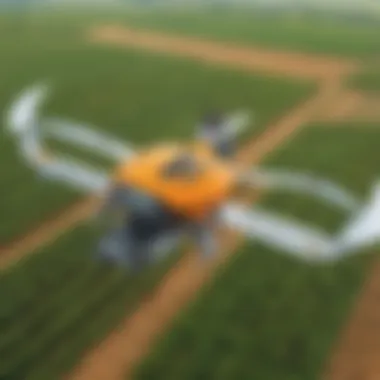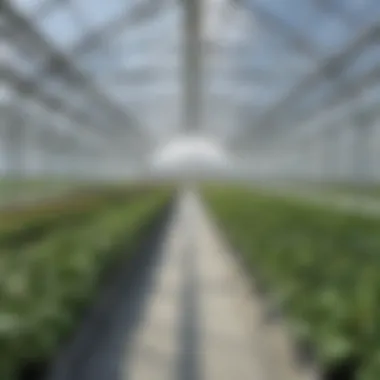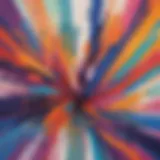Revolutionizing Agriculture: Groundbreaking Invention Ideas for a Sustainable Future


Science Fun Facts
Despite the numerous challenges facing the agriculture industry, innovative invention ideas have emerged to address sustainability and efficiency concerns. From groundbreaking robotics to data-driven smart farming techniques, the future of agriculture is being shaped by cutting-edge technologies. Moving on to the captivating realm of robotics, imagine a scenario where autonomous drones accurately pollinate crops with precision and efficiency. These technological marvels not only save time but also contribute to preserving biodiversity essential for a healthy ecosystem. Additionally, the concept of vertical farming revolutionizes traditional agricultural practices by utilizing vertical space to cultivate crops. This method not only maximizes land efficiency but also reduces water usage significantly, addressing crucial environmental concerns. One intriguing fact that illustrates the impact of advanced agricultural technologies is the development of plant sensors that can monitor soil health in real-time. By providing data-driven insights, farmers can optimize their crop production while minimizing environmental impact.
Discover the Wonders of Science
As we delve deeper into the wonders of science within agriculture, it becomes evident that the potential for innovation is limitless. Exploring various scientific concepts such as bioengineering and genetic modification opens up new avenues for crop enhancement and sustainability. Educational videos and animations serve as valuable tools to engage young minds in understanding the complexities of modern agriculture. By illustrating concepts like carbon sequestration and hydroponic systems through visual means, students can grasp advanced scientific principles with ease. Furthermore, the practical applications of science in agriculture extend to real-life scenarios where climate-resilient crops play a crucial role in ensuring food security. By studying how genetic traits can be manipulated to develop drought-resistant varieties, scientists pave the way for sustainable crop production methods. Through interactive learning tools, children can explore the intricate processes involved in agriculture, from seed germination to harvest. By engaging in virtual farm simulations, students gain a holistic understanding of the interconnected nature of farming practices.
Science Quiz Time
Embark on an exciting journey of discovery with interactive quizzes that test your knowledge of agricultural innovation. From multiple-choice questions on robotic harvesting to brain teasers about soil health monitoring, these quizzes challenge young learners to think critically about the future of farming. By gamifying the learning experience, children can delve into the complexities of agriculture while having fun. Through engaging puzzles that require problem-solving skills, students develop a keen interest in sustainable agricultural practices and technological advancements. Explore thought-provoking questions regarding the ethical implications of genetic engineering in agriculture, challenging participants to consider the broader implications of innovation in food production.
Science Experiment Showcase
Experience the thrill of scientific experimentation with fun and engaging agricultural projects. Follow step-by-step instructions to create seed germination experiments using common household materials, fostering a hands-on approach to learning about plant growth. Discover the critical role of sunlight in photosynthesis by conducting experiments that showcase the process of energy conversion in plants. With safety tips and precautions in place, children can explore the wonders of science in a controlled and educational setting. Engage in soil composition experiments to understand the importance of nutrient-rich soil for crop cultivation. By observing how different soil types affect plant growth, young learners gain insight into the factors that contribute to agricultural sustainability. Unlock the world of agricultural science through immersive experiments that stimulate curiosity and critical thinking skills, paving the way for future innovators in the field of sustainable agriculture.
Introduction
In the realm of agriculture, innovation serves as the catalyst for transformation and progress. The Introduction section of this article sets the tone for a discourse on groundbreaking invention ideas that hold the promise of reshaping the agricultural landscape for a sustainable future. Diving into this narrative unveils the fundamental importance of embracing disruptive technologies and creative solutions to meet the evolving demands of the agricultural sector.
Significance of Agricultural Innovation
Agricultural innovation stands at the core of driving sustainable growth and development within the industry. By harnessing the power of technological advancements and novel approaches, farmers and stakeholders can chart a course towards enhanced efficiency, productivity, and resource utilization. The Significance of Agricultural Innovation delves deeper into how these inventive ideas not only aim to streamline operations but also pave the way for eco-friendly practices that promote long-term sustainability and resilience.


Impact of Technology on Agriculture
The Impact of Technology on Agriculture unveils a paradigm shift in the way farming practices are conducted and managed. By leveraging cutting-edge technological solutions, farmers can optimize yields, reduce wastage, and mitigate risks associated with traditional farming methods. This section sheds light on how technology serves as a force multiplier, enabling farmers to make data-driven decisions, implement precision agriculture techniques, and achieve operational excellence in today's dynamic agricultural landscape.
Overview of Current Agricultural Challenges
Within the realm of agriculture, challenges abound, ranging from climate change and water scarcity to market fluctuations and labor shortages. The Overview of Current Agricultural Challenges paints a comprehensive picture of the hurdles that farmers and industry professionals face on a day-to-day basis. By identifying and understanding these challenges, stakeholders can proactively design and implement innovative solutions that address key pain points, driving holistic growth and sustainable development within the agricultural ecosystem.
Advanced Robotics in Agriculture
Advanced Robotics in Agriculture plays a pivotal role in enhancing the efficiency and sustainability of farming practices. These cutting-edge technologies offer precise control and automation, revolutionizing traditional agricultural methods. The integration of robotics in agriculture positively impacts productivity, resource utilization, and overall crop yields. Autonomous Harvesting Robots are a key component of advanced robotics, streamlining the harvesting process with unparalleled accuracy and speed. These robots reduce manual labor, optimize harvesting operations, and improve efficiency in crop management.
Autonomous Harvesting Robots
Enhanced Efficiency with Autonomous Operations
Enhanced Efficiency with Autonomous Operations represents a groundbreaking advancement in agricultural technology. By automating harvesting processes, these robots significantly increase productivity while minimizing manual labor requirements. The precision and speed at which Autonomous Harvesting Robots operate ensure maximum yield with minimal wastage. Their ability to navigate fields autonomously, distinguish ripe produce, and execute harvesting tasks with precision set them apart in the agricultural landscape.
Impact on Labor in Agriculture
The Impact on Labor in Agriculture introduced by Autonomous Harvesting Robots is substantial. These robots alleviate the physical strain on laborers, reduce the dependency on manual harvesting, and provide opportunities for upskilling in higher-value agricultural activities. Although initially requiring investment, the long-term benefits of reduced labor costs and increased operational efficiency make them a strategic choice for modern farms looking to optimize their processes.
Precision Weed Control Robots
Reducing Herbicide Usage


Precision Weed Control Robots offer a targeted approach to weed management, reducing the need for excessive herbicide application. By precisely detecting and eliminating weeds without affecting crops, these robots promote sustainable farming practices and environmental health. The reduction in herbicide usage not only decreases chemical residues in produce but also minimizes the environmental impact associated with widespread herbicide application.
Enhanced Crop Health Monitoring
Emphasizing Enhanced Crop Health Monitoring enhances farmers' ability to proactively address crop diseases and nutrient deficiencies. These robots utilize advanced sensors and imaging technologies to monitor plant health indicators, enabling early detection of issues and timely interventions. By providing real-time data on crop health and growth patterns, Enhanced Crop Health Monitoring robots empower farmers to make informed decisions, optimize resource allocation, and enhance overall crop quality.
Smart Farming Techniques (at least 300- words):
Smart Farming Techniques play a pivotal role in revolutionizing agriculture towards sustainability. By integrating IoT applications into farming practices, efficiency and productivity are significantly enhanced. These techniques allow for precise monitoring and management of crops, leading to optimized resource utilization. Embracing Smart Farming Techniques ensures a more sustainable approach to agriculture by reducing waste and environmental impacts. The implementation of IoT applications empowers farmers with real-time data and insights, enabling informed decision-making for improved crop yields and quality. Considerations such as initial investment and technological literacy are vital for the successful adoption of these techniques.
IoT Applications in Agriculture (at least 250- words):
- Sensor Technology for Soil Moisture Monitoring: Sensor Technology for Soil Moisture Monitoring is instrumental in optimizing water usage in agriculture. By accurately measuring soil moisture levels, farmers can precisely tailor irrigation practices, preventing both water scarcity and waterlogging issues. The key characteristic of this technology lies in its ability to provide real-time data on soil conditions, allowing farmers to adjust irrigation schedules promptly. Its efficiency in water management makes it a popular choice for promoting sustainable farming practices. However, calibration and maintenance requirements are crucial considerations for its successful integration.
- Data-Driven Decision Making: Data-Driven Decision Making revolutionizes agricultural practices by harnessing the power of information. By analyzing data related to weather patterns, soil composition, and crop health, farmers can make informed decisions to boost productivity and efficiency. The key characteristic of this approach is its ability to enhance predictability and risk management in agricultural operations. Data-Driven Decision Making is a beneficial choice for optimizing resource allocation and streamlining farming processes. Despite its advantages, ensuring data accuracy and privacy protection are important aspects to address.
Vertical Farming Innovations (at least 250- words):
- Utilizing Urban Space Efficiently: Utilizing Urban Space Efficiently transforms non-traditional areas into productive agriculture sites. By repurposing unused urban spaces such as rooftops and warehouses, farmers can increase food production in high-density metropolitan areas. The key characteristic of this innovation is its ability to promote local food production and reduce transportation costs. Its popularity stems from the sustainable utilization of urban landscapes for agricultural purposes. However, challenges in infrastructure and zoning regulations may hinder its widespread implementation.
- Year-Round Crop Production: Year-Round Crop Production ensures a constant food supply regardless of seasonal changes. By leveraging controlled environment agriculture techniques, such as hydroponics and aquaponics, farmers can cultivate crops throughout the year. The key characteristic of this innovation lies in its ability to overcome traditional farming limitations and enhance crop diversity. Its popularity is attributed to the consistent quality and quantity of produce generated. However, factors like energy consumption and investment costs need to be deliberated for successful adoption.
Genetic Engineering Advancements
In this meticulously contemplated article on the theme of Genetic Engineering Advancements, the discourse gravitates towards the quintessence of genetic alterations in an agricultural backdrop. Genetic engineering, with its profound implications, emerges as a linchpin in modern agricultural innovation. The specialized domains within this ambit encompass a panoply of advantages poised to redefine agricultural practices. By optimizing crop characteristics at a genetic level, advancements in genetic engineering hold the promise of bolstering crop resilience, enhancing nutritional value, and mitigating environmental impacts through tailored modifications. The critical nexus of genetic engineering lies in its capacity to imbue crops with attributes that confer resistance to prevailing and future challenges on the agricultural frontier. Furthermore, the judicious application of genetic engineering translates into a regime of sustainable agricultural practices with far-reaching ramifications.
CRISPR Technology in Crop Modification


Enhancing Crop Resilience
The pivotal subdivision of Enhancing Crop Resilience within the purview of CRISPR technology underscores a pivotal facet in modern agriculture. In this competition constrained agricultural hemisphere, the notion of crop resilience represents a cornerstone approach for fortifying crops against adverse environmental factors. The crux of enhancing crop resilience through CRISPR technology resides in the precision targeting of genetic markers that govern stress responses in plants. This bespoke modification engenders crops with inherent fortitude, enabling them to thrive under duress and manifest heightened adaptability. The distinct virtue of enhancing crop resilience lies in its potential to galvanize agricultural sustainability by countering the deleterious effects of unpredictable climatic exigencies, pests, and diseases endemic to the agrarian landscapes. However, the nuanced intricacies of this genetic intervention necessitate comprehensive consideration of ethical, ecological, and regulatory dimensions to ensure the seamless integration of enhanced crop resilience into the agricultural milieu. Despite the burgeoning acclaim, challenges persist in the ethical quandaries pertangth to genetic alterations and the imperative continuity of biodiversity amidst gene-edited cultivars.
Improving Nutritional Content
The facet of Improving Nutritional Content emerges as a lodestar directing the course of agricultural enhancement through CRISPR technology. At the vanguard of this transformative endeavor lies the ethos of elevating crop nutrition by interfacing genetic engineering with personalized dietary requisites. The salient feature of improving nutritional content accentuates the augmentation of essential nutrients, bioavailability, and dietary diversity in staple crops, thereby addressing malnutrition and nutritional deficiencies prevalent in varied demographics. The efficacy of this approach lies in tailoring crops to imbue them with heightened levels of specific vitamins, minerals, antioxidants, and supplementary nutrients vital for human sustenance. By magnifying the nutritional profile of crops, agricultural systems can transcend conventional paradigms and engender profound health benefits for consumers worldwide. Nevertheless, the adoption of genetically modified crops designed to enhance nutritional content demands meticulous oversight to preclude unintended repercussions and assure consumer safety, underscoring the imperativeness of stringent regulatory frameworks and transparent research methodologies in propelling this trajectory of agricultural innovation.
Disease-Resistant Crops Through Genetic Modifications
The segment encompassing Disease-Resistant Crops Through Genetic Modifications heralds a watershed moment in agricultural evolution predicated on genetic fortification against prevalent pests and diseases. Anchored on the premise of streamlining crop protection strategies while minimizing environmental impacts, genetic modifications pose a game-changing paradigm in pest management. The focal tenet of reducing dependency on pesticides emphasizes a shift towards sustainable pest control mechanisms that obviate the indiscriminate usage of chemical agents deleterious to ecological equilibrium. The strategic deployment of genetic modifications to confer resistance against pest incursions enhances crop longevity, yield stability, and agronomic reliability, engendering a paradigm shift towards integrated pest management methodologies that are eco-friendly and economically viable. Nevertheless, the consolidation of disease-resistant crops through genetic modifications hinges on intricate risk-benefit analyses to navigate regulatory scrutiny, stakeholder perceptions, and the exigencies of coexistence between genetically modified and conventional cultivars in a biodiversity-rich agrarian fabric.
Sustainable Agriculture Practices
Sustainable Agriculture Practices play a pivotal role in shaping the future landscape of farming. In the context of this article, these practices encompass a range of methods and techniques aimed at promoting environmental sustainability, optimal land use, and long-term agricultural productivity. By focusing on sustainable agriculture, farmers can reduce their ecological footprint, enhance biodiversity, and mitigate the negative impact of conventional farming practices on the environment. At the heart of sustainable agriculture lies the idea of harmonizing agricultural activities with nature's cycles and preserving natural resources for future generations. Embracing sustainable agriculture practices is not only beneficial for the environment but also for ensuring food security, improving soil health, and fostering resilience against changing climatic conditions.
Agroforestry Techniques
Integration of Trees into Crop Production
The Integration of Trees into Crop Production stands as a cornerstone in sustainable agriculture practices. This innovative approach involves strategically incorporating trees within crop cultivation systems to create synergies and maximize agricultural outputs. By intermixing trees with traditional crops, farmers can diversify their produce, enhance soil fertility, prevent erosion, and provide habitats for beneficial wildlife. One key characteristic of this practice is its ability to create microclimates that support crop growth and improve overall ecosystem health. The integration of trees into crop production not only boosts farm yields but also contributes to carbon sequestration, water conservation, and landscape aesthetics. Despite its numerous advantages, challenges such as competition for resources and management complexities need to be carefully addressed for successful implementation.
Organic Farming Innovations
Promoting Soil Health
Promoting Soil Health is a fundamental aspect of organic farming innovations within the realm of sustainable agriculture practices. This focus area emphasizes nurturing soil biodiversity, optimizing nutrient cycles, and minimizing chemical inputs to cultivate healthy and resilient soils. Maintaining soil health is vital for sustaining crop productivity, improving water filtration, and fostering plant nutrient uptake. One key characteristic of promoting soil health is its emphasis on organic matter enrichment, which fosters beneficial microorganisms and enhances soil structure. By prioritizing soil health, farmers can reduce erosion, sequester carbon, and enhance crop quality organically. While the benefits of promoting soil health are substantial, challenges related to managing soil pH, nutrient availability, and weed control need strategic planning and continuous monitoring for successful organic farming practices.
Chemical-Free Crop Cultivation
Chemical-Free Crop Cultivation represents a revolutionary stride towards sustainable agriculture practices. This approach advocates for the elimination of synthetic chemicals, pesticides, and fertilizers in crop production, focusing on natural alternatives and biological methods for pest and weed management. The key characteristic of chemical-free crop cultivation lies in its commitment to preserving ecosystem balance, safeguarding human health, and promoting biodiversity within farmlands. By adopting chemical-free cultivation methods, farmers can reduce environmental pollution, protect beneficial insects, and produce crops free from harmful residues. The unique feature of chemical-free crop cultivation is its potential to create resilient agroecosystems that are self-sustaining and biologically diverse. However, transitioning to chemical-free practices requires careful planning, farmer training, and integrated pest management strategies to address pest outbreaks and maintain crop yields sustainably.







